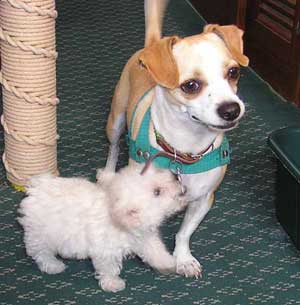Storing dry dog food on a boat has some special considerations. After all, you don’t want it to get moldy. Or worse, infested with bugs. So what’s the answer?
Adopting a Boat Dog
We adopted/rescued our dog, Paz, when she was just 4 weeks old. And as you can see from the photo of her a few days later, she loved her kibble. Not knowing any better, I just kept it in its bag under the nav station.
Within a couple of weeks, though, Paz turned up her nose at her own food bowl. But she devoured the exact same food aboard a friend’s boat (luckily, their dog Sophie didn’t mind sharing). And then a few days later I discovered ants in our bag of kibble. That bag went in the trash and I went over to Amazing Grace to talk to Sophie’s mom about the problem.

Over the next few weeks, Tonya taught me about being a dog mom, and Sophie taught Paz about being a dog since Paz’s “birth mother” hadn’t been able to.
Learning about Storing Dry Dog Food
Tonya’s first question to me was how did I store our cereal. Did I just roll down the top of the bag and stick it under the nav station?
Well, no. If I did that, the cereal would quickly get stale from the humidity and full of bugs from being left open. And so it hit me: Paz’s food had gotten stale (why she had turned up her nose at it) and then full of ants. I later learned from other friends that dog food is also susceptible to weevils.
Our Storage Method
The next bag I stored just as I did Dave’s Cheerios.
1. Just like cereal, kibble needs to go in a plastic bin with an airtight lid. I originally used the Rubbermaid Lock-It 2-1/2 gallon (40 cup) container that was airtight. Sadly, Rubbermaid has replaced those with their Brilliance locking containers (Amazon). I don’t have personal experience with them but they are highly rated. There is also a Lock & Lock container (Amazon) that’s more of a “bin” design which seems very convenient. But several reviews in numerous places state that it does not have a totally airtight seal. That means that both moisture and ants will get in. If they are your only option, you may be able to increase the seal with putting plastic wrap on before locking the lid.
2. Like many other grain-based foods, adding a couple of bay leaves (Amazon) will discourage the weevils. Of course, don’t give the dog the bay leaves—although our vet says they’re not toxic.
3. And putting a drop of clove oil (Amazon) on the outside of the lid will discourage ants. Note that most dogs don’t like a strong taste of cloves in their food, so don’t put cloves in the dry food. Again, cloves aren’t poisonous to dogs.
NOTE: While bay leaves and cloves aren’t considered to be toxic to dogs, it’s always possible that a particular dog could have an allergy. I know all about weird allergies—Paz is allergic to rawhide!
Shopping for Dog Food
A couple of other notes on dog food. We could always find some type of dog food in Mexico and Central America. Larger cities typically had better brands of dog food, which were usually sold at vet offices. Further, just as with flour, we soon learned that buying kibble in larger stores—or large vet offices—had far less chance of weevils and other bugs.
And we learned to transfer the food to its plastic container immediately upon taking it on board and getting rid of the bag—and potential bugs—immediately.
UPDATE: After a while, we switched to Sojo’s freeze dried dog food (Amazon). Read my post about why it works well on a boat. And I can store unopened bags just as they come from Amazon, but I still store open bags this way—I just use a smaller canister!
I’d assume that cat food should be stored the same way as dog food, but we’ve never had a cat and thus I don’t really know if there are any differences. If you have any knowledge of cat food, please add a note in the comments!

Carolyn Shearlock has lived aboard full-time for 17 years, splitting her time between a Tayana 37 monohull and a Gemini 105 catamaran. She’s cruised over 14,000 miles, from Pacific Mexico and Central America to Florida and the Bahamas, gaining firsthand experience with the joys and challenges of life on the water.
Through The Boat Galley, Carolyn has helped thousands of people explore, prepare for, and enjoy life afloat. She shares her expertise as an instructor at Cruisers University, in leading boating publications, and through her bestselling book, The Boat Galley Cookbook. She is passionate about helping others embark on their liveaboard journey—making life on the water simpler, safer, and more enjoyable.

Carolyn Shearlock says
Two that have worked for friends:
1. Is there a nearby boat with a cat who is a “known” mouser? If so, borrow it for a few days, if you don’t have a major cat allergy. In all seriousness, this worked well — results within a day — for two boats that we know of . . . but not all cats are mousers!
2. A trap, baited with peanut butter. Peanut butter seems to work much better than the better-known cheese. You can keep traps out of reach of kids and pets, and the critter will end up in a location where you can dispose of it. Make sure that the trap is right for the critter — that is, a mouse trap for a mouse, a rat trap for a rat — as one that is too small or too large will be ineffective.
You can also use poison (such as D-Con), but I don’t like to for a couple of reasons: (1) the critter is likely to go off in a really inaccessible place to die, and will begin to decompose there — and stink up the whole boat; and (2) if you have any children or pets aboard, they can get into the poison.
If you are still in the marina or boat yard where you think it came aboard, you need to watch out for more (I know, this isn’t what you want to hear). One option is to leave and anchor out — if your boat is not connected to shore, they can’t come aboard. But that often isn’t practical. I saw one boat with “rodent shields” on their dock lines and just found them at Amazon:
Mouse & Rat Guards
Inasmuch as the owners of this boat weren’t aboard when we were there, I honestly don’t know if they are effective, or whether you could make something similar yourself.
Good luck!
-Carolyn
Bruce M Bibee says
One can repurpose a plastic bottle of the appropriate size for your line by cutting the bottom of the bottle off and puting it on the line big opening out (like making a funnel) prior to connecting the line to the dock. The bell needs to be long enough so the rat cannot jump over, but not so long that it makes a ramp. Rats here in the Philippines are fast and accomplished swimmers so any line leading to the boat from the water needs to be protected. The rats here are also very fast on their feet and can hide anywhere – our ten kilogram dog cannot catch them, nor get to them in the small spaces in which they can hide. I have seen them escape from Pearl by simply jumping ship if they are in the open. Fortunately Pearl has enough sense not to jump in after them (being satisified with barking). Have a good day.
The Boat Galley says
She was only about 6 weeks old there!
Sabrina says
We also use the Gamma lids. You can now buy them at Farm & Fleet in our area. Farm & Fleet also carries food grade 5 gallon buckets to put the Gamma lid on. We don’t live on our boat either but, we do leave our dog food on board when we leave. After some lengthy repairs to our boat recently, it was almost 6 weeks before we saw it again. Very pleased to say, the dog food was just fine. No moisture and smelled just as fresh as when we left. Dunkel, our 1 1/2 year old Labrador, thought it was just fine as well. We are very pleased.
Carolyn Shearlock says
Congrats on the new puppy!! I’ve found that dog food bags don’t do that well over the long term as the closing mechanism just doesn’t seem durable enough and then don’t seal tightly. It’s a bit of a pain to transfer the food into another container, but it seems to be the only way to keep it fresh . . . and bugs out of it!